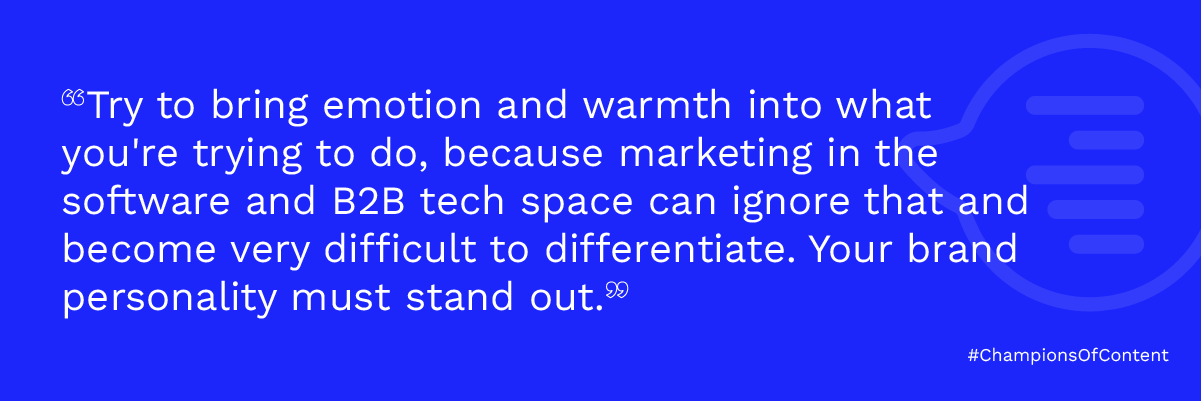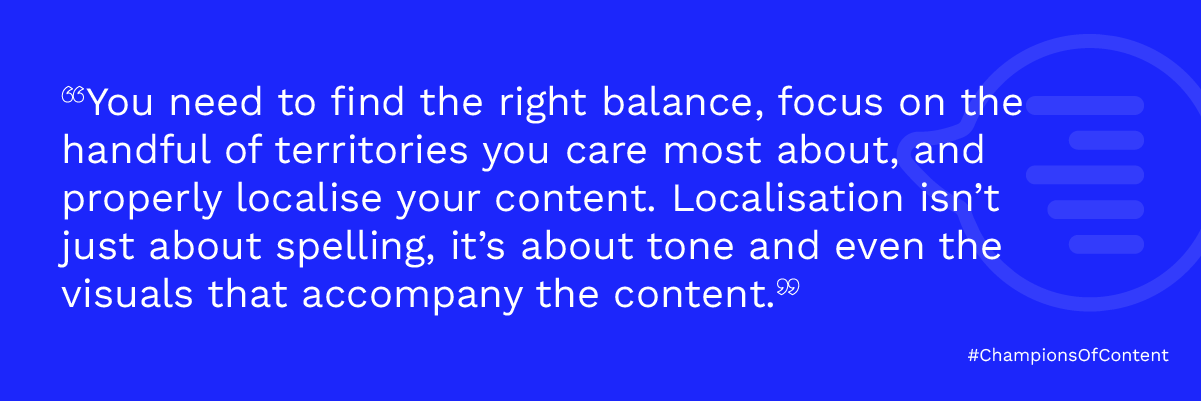Champions of Content – Q&A with Bhavesh Vaghela: Chief Marketing Officer at ActiveOps
Welcome to the next instalment of our new series: Champions of Content.
Content is integral to the way brands are understood and seen by their audiences, but developing content for different audiences, on different channels and even in different languages can be very complicated to get right.
In Champions of Content, we’ll be speaking to passionate content creators we admire including marketers, journalists, writers, podcasters, and speakers about their experiences and sharing the wisdom to help others on their own content journey – whether your first putting pen to paper or looking to level up your content strategy.
For more than 20 years, Bhavesh Vaghela has provided strategic leadership and creative guidance in marketing, sales and operations across the tech industry. Across his career as a B2B tech marketer, he has climbed the ladder from marketing manager to VP and Chief Marketing Officer, and worked with a range of companies, such as the call tracking software provider ResponseTap.
Bhavesh was the CMO and later the CEO for the subscription management platform Singula Decisions. Since August 2022, he has worked as the CMO for ActiveOps, a leading provider of workforce management software.
In this edited conversation, we discuss the role of content in marketing today, the importance of forming an emotional connection with your audience even in the functional B2B tech space, and what impact ChatGPT might have on content creation.
Bhavesh, please can you start by telling us about your own career journey as it relates to content and what role content plays in your work today?
During my career, I’ve worked at software businesses ranging from startups to established companies through to some very large organisations, all at radically different stages in their growth journey.
Marketing has evolved during that 20-year span, and some things – especially the audience that B2B firms target with content – has changed dramatically in several ways.
Years ago, the focus of content was about outreach and getting your sales teams in front of the audience. But today, many buyers will have already made their decision long before they ever engage with a vendor like ActiveOps. Over that time, the role of content has evolved and is now about creating a positive perception of your brand in the minds of your prospect base, customer base and target account, helping them to form a view of your organisation before you are even aware that they are looking for a solution.
The other big change concerns the role of influence. In the early days, mapping the influencers with a particular market was relatively straightforward: analysts and journalists were the core dominant influencers. But now, it is completely fragmented. Today, there are so many different types of influencers, including academics, individual customers who are prominent on social media, specialist experts, and so on.
As a result, you have got to cut through much more noise, because everybody is doing the same thing.
The big challenges today are: how do you make yourself different, and how do you communicate to the right individuals?
At ActiveOps, content plays an important role throughout our sales funnel, from trying to build momentum at the top end and accelerate the sales journey, all the way through to the bottom where you are trying to upsell and grow your existing accounts.
At the top end of the funnel, you’re trying to drive demand and get your prospects to form an opinion about your brand. Thought leadership content is crucial at this point, because it will help an individual or an organisation form a view of the type of business you are, what services you provide and what expertise you have, because customers want to buy expertise.
Content can also give your prospective customer the confidence that they are in the right place and you have the kind of solution they are looking for. The bottom line is that content is one of the most critical factors for winning new customers, as well as growing existing accounts.
Whose content – brands or individuals – do you admire most and why?
Today, we are absolutely bombarded with content, and most of it is lukewarm, not differentiated, or fails to attract your attention. In my opinion, it is content that makes you stop and think that really sticks with you.

There was a period where companies like HubSpot did a phenomenal job on their content strategy. More recently, Indeed did a great campaign around the gender pay gap, showing pictures of food with a bite taken out or consumer products missing pieces and asking the reader if they would accept 16% less. If not, then why should women? Instantly, there is a strong emotional reaction to the content.
Every organisation can create great content if they think differently about how they are doing it. The campaigns that work for me personally are the ones that connect to me emotionally. Tapping into people’s emotions can make all the difference to the success of a campaign, but that is much easier said than done.

We all want our content to stand out. What do you think are the main ingredients that make one piece of content stand out above another?
One of the earliest lessons I learned was to treat people like people. Try to bring emotion and warmth into what you’re trying to do, because marketing in the software and B2B tech space can ignore that and become very difficult to differentiate. Your brand personality must stand out. The other lesson is to try and market to the edge of the table, because everybody tends to focus on the same thing.

One example of putting this into practice was on a campaign I ran many years ago aimed at compliance. It was a few years after the Sarbanes-Oxley Act of 2002 had come into force in the US, which carried criminal penalties for corporate misconduct. All the messaging around at the time was very “doom and gloom” and fearful, warning businesspeople that they could go to jail if they failed to comply with the new law.
The heads of compliance at big businesses were constantly being bombarded by these kinds of messages. So, our campaign took a different approach, which we called the Compliance Lover’s Guide.
At the time, other campaigns seemed to characterise compliance officers as dull and grey. We twisted that message, focusing on how passionate these people were about compliance, and produced funky bumper stickers that read “I ♥ compliance”. We sent stickers to compliance officers within our target accounts. It worked well and captured their imagination. A few senior compliance officers even called us to ask for more stickers!
What are some of the challenges you face when producing content for different channels and audiences, and how do you deal with these? Here at Tyto, we often navigate the complexity of developing content for different audiences in different countries.
Much of B2B tech content is very functional. It will tell you about the features, functions, or key elements of a product of service. It’s very corporate, but people don’t think or talk that way.
Similarly, the senior figures within a B2B tech company, such as the CEO, can often be technologists. They are passionate about these features and functions. So sometimes you need to reel them back in and explain: why should our target audiences care about this new feature?
In these situations, the real challenge for marketers is to present their ideas with confidence and conviction. Convincing an executive team to go along with your idea might not depend on how creative it is, but how well you articulate it. Why do you want to proceed with your idea? Why does it make sense to target a given audience in this way?
Once you’re successful with one campaign, that can help convince the executive team in the future. For instance, with the Compliance Lover’s Guide, a few days after we had sent out the bumper stickers, the CEO of my company called me. He was excited because he had just seen a passenger on the Tube with one of the stickers across their laptop. He was overjoyed to see the evidence of the campaign’s success in the real world – and that gave him confidence in what the marketing was able to achieve.
Overall, you need to understand whether your executive team is very traditionalist or more adventurous, and that will help you to gauge how far out your ideas can be and how you get their buy-in. It often comes down to how much conviction and belief you have in your marketing strategy; without that, your pitch will fall flat on its face.
Another challenge is how you navigate the complexity of developing content for different markets. It’s a difficult and fine line to tread, because creating relevant and nuanced content for every territory is expensive compared to creating a standardised global campaign. There aren’t many companies who can get away with the latter, and it may not look good if you try.
You need to find the right balance, focus on the handful of territories you care most about, and properly localise your content. Localisation isn’t just about spelling, it’s about tone and even the visuals that accompany the content.

Are you excited by AI and ChatGPT, and if so, where do you see the greatest potential to harness is in the development of content, now or in the future?
I think we’ll get a lot more content. It will be much faster to produce content, and it may even help with localisation, as well as creating and rewriting content in different ways for different audiences and publications.
What it won’t do is put emotion into the content, and that’s the thing you need to tie your campaign together. It will be up to us as marketers to take what AI produces as an inspiration or starting block, and transform it into something that truly resonates with audiences.
For brands or individuals planning to level up their content in 2023, what would be your top three bits of advice for how they can increase the impact of their content? What should they be thinking about and looking at? What are you thinking about?
First, know your audience. Form an emotional connection with them, which will influence their decision to buy from you. You need to wrap that emotion into your content.
The second thing is that emotional connection will need to be related to a theme. So, make sure it’s clear what you’re trying to communicate and be confident in the way you get it across.
Finally, think about all your different available channels. Once you’ve created content that is valuable, resonates and is differentiated, consider how it will play across the different channels that you’re trying to engage with. You will need to be able to track and measure its impact, so you can decipher what is working and what is not.











